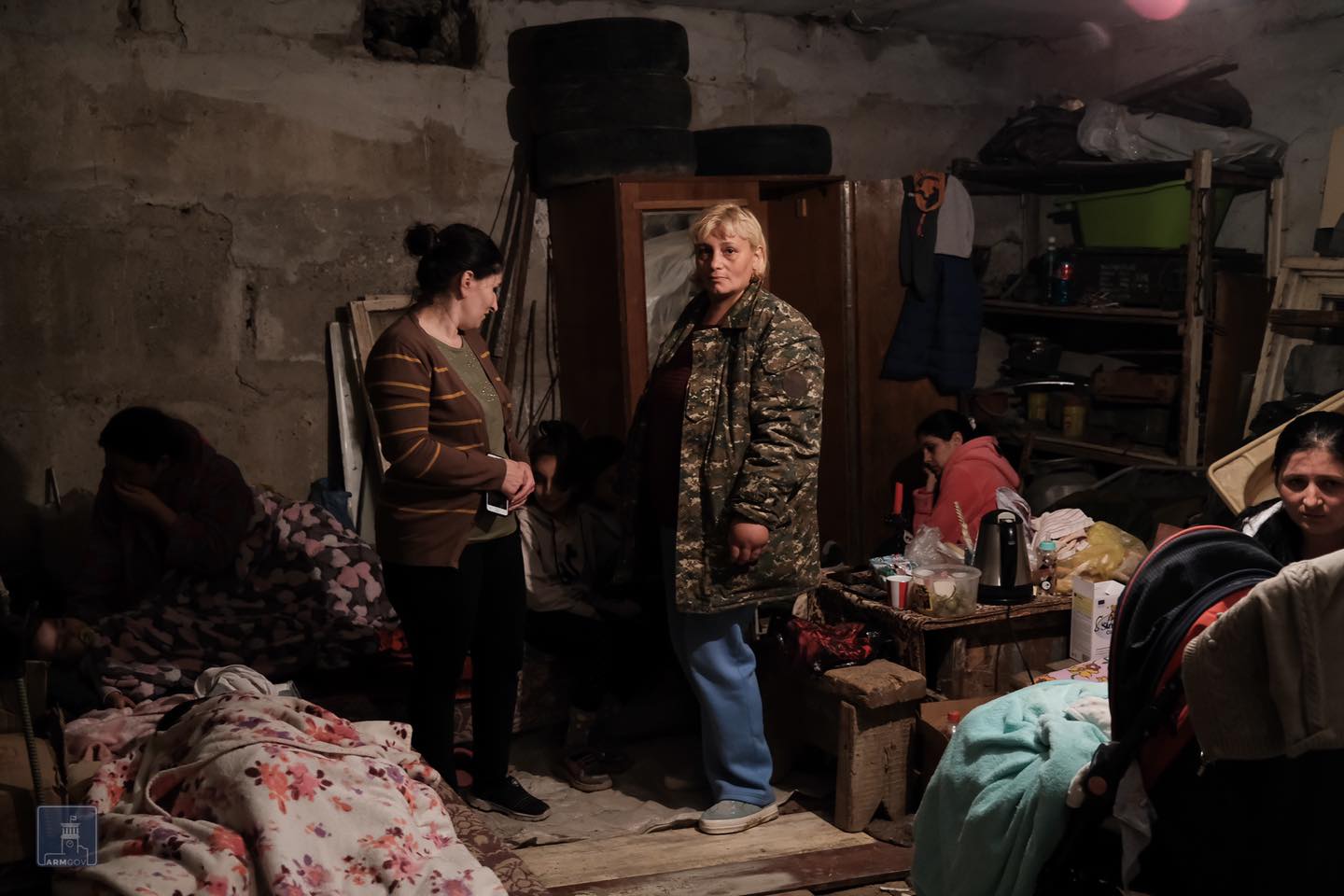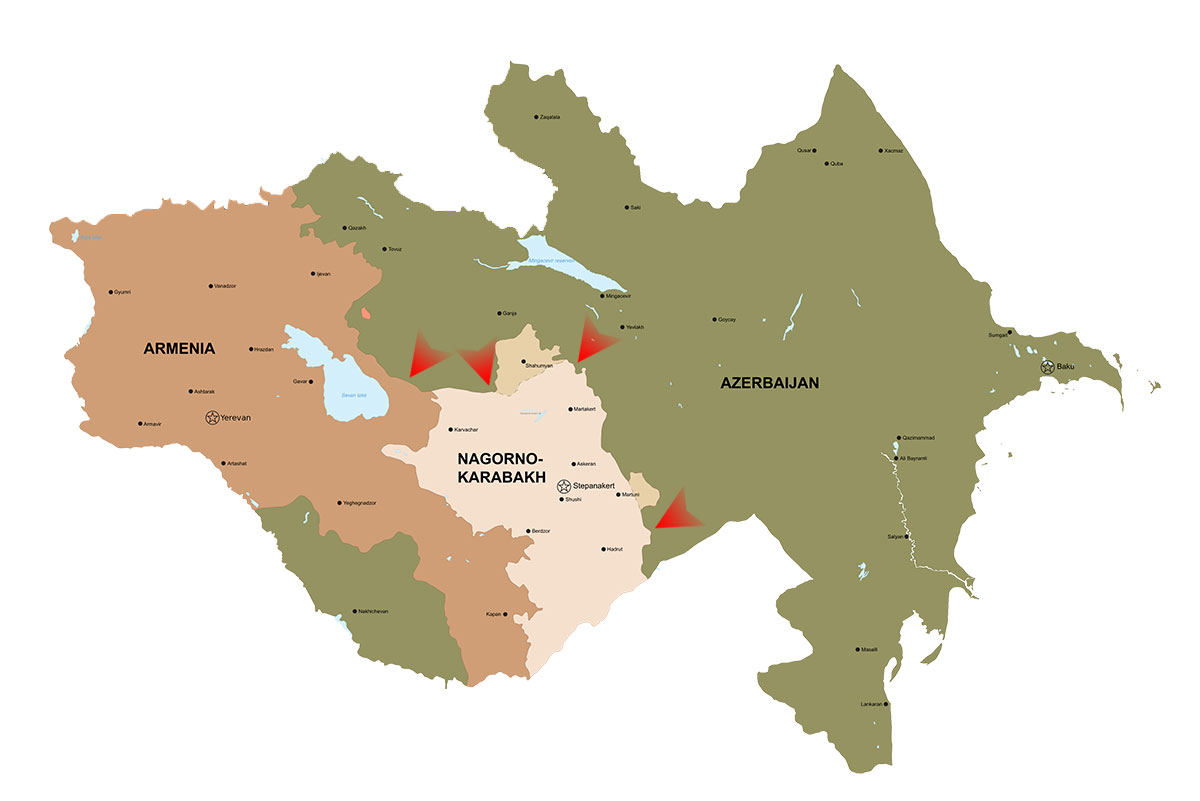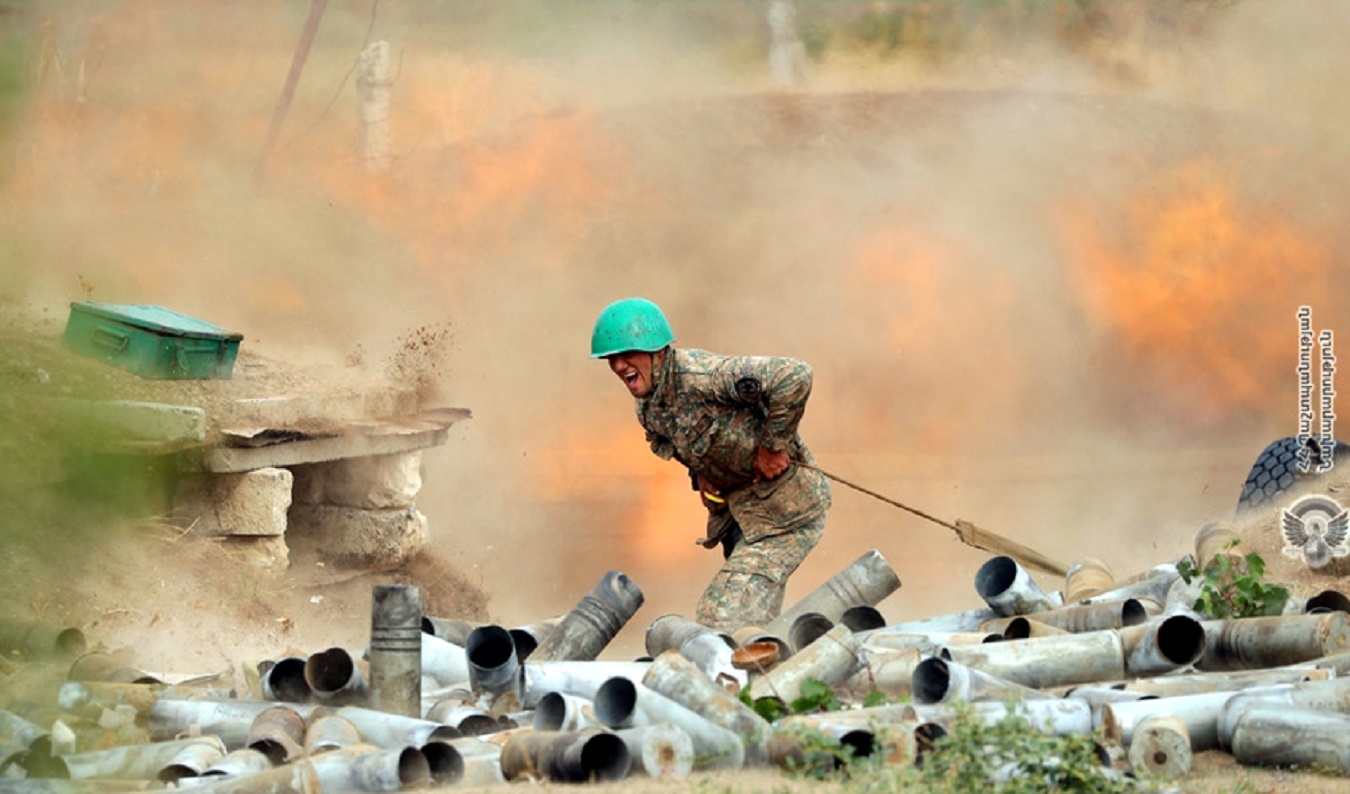The new war provoked by the Azerbaijani army is much broader than the four-day war of April, 2016. It differs in its scale, objectives and especially the intensity of the battles. It is considered probable that it may last longer than the April war in 2016.
The adversary does not discern between means during hostilities, targeting both the military and the civilian population.
Azerbaijan against Artsakh
The attack of the Azerbaijani army along the entire line of contact of Artsakh started on Sunday, September 27, at about 7:10 am. Not only Armenian positions but also settlements were targeted with missiles and artillery. Two civilians, a woman and a child, died as a result of the Azerbaijani shelling in the Martuni region.
“There are casualties among the civilian population due to the Azerbaijani shelling. Two people were killed in Martuni region, a woman and a child, there are two wounded. Data for other settlements are being verified. Schools were also shelled, including in Stepanakert. There is large-scale damage to civilian infrastructures in many settlements”, – says Artak Beglaryan, Artsakh Human Rights Defender.
On the very first day of the war, the capital of the Artsakh Republic, Stepanakert, was targeted by the Azerbaijani artillery, strike drones. Residential buildings were damaged. And the population had to take shelters in basements.
Later it became known that there were dozens of injuries among the civilian population.

In fact, the Azerbaijani armed forces do not discriminate between targets during the attack, firing and launching missiles at the civilian population and civilian infrastructures.
The fact-finding group of the Artsakh Human Rights Defender’s Office recorded on the first day of the wholescale attack by Azerbaijan that all large and a number of small settlements (including Stepanakert, Askeran, Martakert, Martuni, Hadrut, Shushi towns) were shelled with the use of artillery and striking UAVs.
The Azerbaijani UAVs also reached the city of Vardenis of the Republic of Armenia.
Before that, on September 28, the Azerbaijani armed forces pursued the journalists conducting their professional duties in Artsakh with a drone. On September 29, the Reporters Without Borders (RSF), an international professional human rights organization, published a statement condemning this.
The next day, September 29, the RA Human Rights Defender Arman Tatoyan stated that no distinction was made between the “military facilities” and the civilian population.
Fake Messages. What is not true?
It is obvious that the Armenian side has never refused the negotiations. Moreover, the Armenian authorities have repeatedly stated that there is no alternative to negotiations, the Artsakh issue has no military solution. This is also repeated by the representatives of the international community, in particular, the OSCE Minsk Group, which has undertaken the mediation mission of a peaceful settlement.
However, after the defeat in July of this year, the Azerbaijani authorities’ rhetoric was even more aggressive against Armenia. The July battles could not drain the bile of the Azerbaijani side. The Baku propaganda machine continued to accuse Yerevan of thwarting the negotiations on the settlement of the conflict.
All these were on the highest level included in speeches of the President of Azerbaijan Ilham Aliev. In particular, it was said as if:
- The statement of the Prime Minister of the Republic of Armenia, “Karabakh is Armenia”, dealt a serious blow to the negotiation process (September 19, interview),
- “The Prime Minister of the Republic of Armenia has announced about the creation of an armed militia out of tens of thousands of civilians who will be forced to take part in military operations against Azerbaijan. It clearly shows the new aggressive intentions of the Armenian leadership” (September 21, Speech 1 at the UN General Assembly),
- “Armenia purposefully targets the civilian population, carries out provocations, kills civilians” (September 21, Speech 2 at the UN General Assembly),
- “There is information in our intelligence sources that very serious military preparations are underway, they are gathering at the contact line of their armed forces at the state border. We are following the situation, we will defend ourselves, both in Tovuz and in other situations. If they attack us, they will regret it” (September 25, Statement at the meeting with the EU Special Representative).
All these statements do not correspond to reality but these are addressed to the international community, aimed at justifying Azerbaijan’s further actions.
Baku was preparing for war and did not hide it. Hence, with such disinformation, Azerbaijan tried to motivate the war by blaming the Armenian side.
Turkey and neighbors
In the past, in the context of the Artsakh conflict, Turkey supported Azerbaijan only through statements. Ankara, however, has become more and more aggressive in recent years. The Turkish authorities are trying to spread Turkish influence throughout the region.
- Turkey oppresses the Kurds by destroying their settlements just in Turkey
- Turkey deploys military base in Iraq as opposed to Baghdad
- Turkey has occupied the northern territories of Syria
- Turkey creates tension in the Greek islands
- Turkey sends troops to divided Libya
- Turkey is looking for gas in the exclusive economic area of Cyprus
Turkey does all this freely, without taking into account the norms of international law and the established relations. If in the past Ankara had at least accepted the principle of “0 problems with neighbors”, now it openly adheres to the principle of “0 neighbors without problems”.
This year, Turkey has begun to actively aspire to participate in the settlement of the Artsakh conflict. Moreover, it is done exceptionally in anti-Armenian context.
In the diplomatic-political context, this is reflected in the fact that Turkey is trying to increase its role in the mediation mission in the Minsk Group.
At the same time, Ankara is openly and unilaterally supporting and even providing assistance to Azerbaijan. One of the vivid examples of that is the statements of the Turkish side during the July battles that they are ready to die for the sake of their Azerbaijani brothers.
Turkey’s military involvement in the Azerbaijani armed forces is more substantial. The Turkish army servicemen and the air force, F16 fighter jets, have been transferred to Azerbaijan for a long time under the name of military exercises and stayed there.
Ankara provides military instructors and specialists to Azerbaijan. And during the recent battles, Turkish reconnaissance ATSs are on duty near the Armenian-Turkish border. According to the already confirmed data, Turkish Bayraktar TB2 attack drones were used by the Azerbaijani side during the war that started on Sunday.
Moreover, in the second half of September 29, it was registered that Turkey was carrying out direct aggression against Armenia. It was the F-16 plane of the Turkish army that shot down the Su-25 plane of the Armenian armed forces in the direction of the Armenian city of Vardenis. The pilot was killed.
Later the same day, the commander of the Artsakh Defense Army announced that a Turkish F-16 had been used in the airspace of Artsakh.
“Turkish F-16 fighter jets are currently flying over Nagorno-Karabakh and are fully involved in hostilities. Turkey does not keep it a secret, only two countries have said they are going to resolve the Nagorno-Karabakh conflict by military means, the first being Azerbaijan and the second being Turkey. Nagorno Karabakh and Armenia are facing an existential threat,” RA Prime Minister Nikol Pashinyan told the BBC in the same evening.
Turkish Troops and Mercenaries
The presence of Turkish troops and equipment in Azerbaijan was known. The Armenian side was also aware that Baku was holding reservist gatherings, recruiting and inspecting vehicles. Moreover, before the attack of the Azerbaijani army, the intentions of Baku on the actual hostilities were already clear to the Armenian side.
As Arayik Harutyunyan said, only the day was not known, in general, the war was expected.
At the press conference held on the evening of the first day of the war, Arayik Harutyunyan mentioned that not only the Azerbaijani armed forces are fighting against Artsakh, but also Turkish army servicemen and subdivisions, mercenaries from abroad, etc. On the Armenian side, the Artsakh Defense Army and reservists are taking part in the battles.
“We must be ready for much heavier, much longer military operations, dear compatriots. The adversary has used all its military forces and continues to use them,” Harutyunyan said while summing up the situation on September 28.
For two days, the Azerbaijani side was provoking battles in all directions. However, it is possible to distinguish three directions:
- South: Fizuli-Jabrail,
- Northeastern: Talish-Mataghis,
- North: Mravi Mountains, Omar Pass.
On September 29, one more direction was added – Vardenis, the south-east of the Gegharkunik province of the Republic of Armenia. This meant an attack directly on the internationally recognized territory of the Republic of Armenia and the expansion of hostilities.

Azerbaijan started the attack in the direction of Vardenis by spreading misinformation that the attack was allegedly launched by the Armenian side in that direction. The RA Ministry of Foreign Affairs denied it in no time. However, Azerbaijan, first of all, launched an attack not only on the frontline positions but also on Vardenis and the surrounding villages, using the air force, UAVs and then artillery.
During the attack in this direction, the Azerbaijani armed forces hit a civilian bus. A civilian who was the driver of the bus was killed. Later, while presenting the local situation, Artsrun Hovhannisyan, MoD representative, mentioned that one of the goals of the Azerbaijanis was to blow up the railway, which did not succeed.
According to Artsrun Hovhannisyan, during the battles Azerbaijani army uses reactive volley stations of 300 and more calibers it has in its arsenal: “Smerch”, “Kasirga”, “Polonez” etc. And the density of artillery use, the density of fire are unprecedented.
On the morning of September 29, it was reported that TOS, Smerch and other large-caliber systems were used against Armenia / Artsakh, which changed the logic and scope of hostilities, raising it to a new level. Artsrun Hovhannisyan informed:
“The Ministry of Defense warns that the Armenian Armed Forces will be forced to use weapons with wide-area impact, able to destroy manpower, transportable or fixed property in large areas.”
Moreover, it was the TOS-1A artillery that the Azerbaijani army deployed in the settlement, near residential houses, and fired from the territory of the settlement, using the civilian population as a live shield.
Causalities
During the first three days of the fighting, according to the official data of the Ministry of Defense, 58 servicemen of the Armenian Armed Forces died. Another 200 servicemen were wounded, but about 80 of them were discharged from medical institutions shortly after due to not much serious wounds.
During the briefing on the morning of September 29, the RA Human Rights Defender reported that there were 4 victims and dozens of wounded among the civilian population, including women, children and the elderly.
Unlike the Armenian side, the Azerbaijani armed forces provide very scanty information about their human causalities. According to the Armenian side, the number of dead servicemen in Azerbaijan during the three days of fighting was 790, the number of wounded – 1900 people.
According to the same official sources, the Azerbaijani armed forces lost a large amount of military equipment. At the end of the second day of the fighting, among the losses of Azerbaijan are:
- 137 tanks and other armored vehicles,
- 72 drones
- 7 helicopters,
- 1 plane.
The military equipment of the air defense (unknown number) is known among the causalities of the military equipment of the Armenian side, as well as the Armenian Su-25 plane that was hit by the Turkish plane on September 29.
Article by Garik Harutyunyan
Responsible Editor Suren Deheryan
For Armenian original CLICK HERE
Read also
© The copyright of stories and visualizations on Ampop.am belongs to “Journalists for the Future” NGO. It is forbidden to use Ampop’s content and images without active hyperlinks to the source website. Uploading of infographics and images of Ampop.am is possible only in case of an agreement reached with JFF.
Փորձագետի կարծիք
First Published: 01/10/2020









